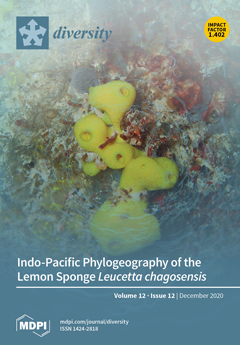The phylogeny and taxonomy of freshwater mussels of the genus
Castalia in South America is complicated by issues of morphological plasticity and limited molecular genetic data. We present field data on the distributions of the nominal
Castalia ambigua and
C. inflata in the upper Paraguay River basin in Brazil based on original occurrence data at 23 sample sites and on historical records. The upper basin has distinct highland and lowland regions, the latter including the Pantanal wetland, where “
C. ambigua” occurs in the highlands and “
C. inflata” occurs in both regions. At Baixo Stream in the highlands, we observed individuals with shell morphologies of either
C. ambigua or
C. inflata, and also individuals with intermediate shell morphology. DNA sequence variation in the upland Baixo Stream and two representative lowland populations were screened. Two mitochondrial and three nuclear genes were sequenced to test hypotheses regarding the number of species-level phylogenetic lineages present. Reported individual DNA sequences from Amazon-basin
C. ambigua and other
Castalia and outgroup species were included in the analysis as outgroups. Individuals from the Paraguay River basin exhibited 17 haplotypes at the mitochondrial cytochrome oxidase I (
COI) gene and nine at mitochondrial
16S rRNA. Analysis of haplotype networks and phylogenetic trees of combined
COI +
16S rRNA sequences among individuals with the respective shell morphologies supported the hypothesis that
C. ambigua and
C. inflata from the Paraguay River basin belong to the same species and one phylogenetic lineage. No variation was observed at the nuclear
18S rRNA internal transcribed spacer,
28S rRNA, or
H3NR histone genes among individuals used in this study. Across all markers, less variation was observed among Paraguay basin populations than between Paraguay and Amazon basin populations. Our results collectively suggest that: (1) “
C. ambigua”, “
C. inflata”, and morphologically intermediate individuals within the upper Paraguay drainage represent one phylogenetic lineage, (2) a phylogeographic divide exists between
Castalia populations occurring in the Paraguay and Amazon River basins, and (3) the evolutionary and taxonomic uncertainties that we have identified among
Castalia species should be thoroughly assessed across their distribution using both morphological and molecular characters.
Full article





